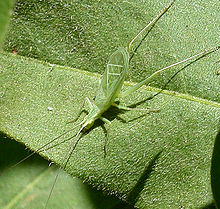- Dolbear's Law
-
Dolbear's law states the relationship between the air temperature and the rate at which snowy tree crickets (Oecanthus fultoni, a tree cricket) chirp[1]. It was formulated by Amos Dolbear and published in 1897 in an article called The Cricket as a Thermometer.
The chirping of the more common field crickets is not as reliably correlated to temperature — their chirping rate varies depending on other factors such as age and mating success. In many cases, though, the Dolbear's formula is a close enough approximation for field crickets, too.
Contents
Equations
Dolbear expressed the relationship as the following formula which provides a way to estimate the temperature TF in degrees Fahrenheit from the number of chirps per minute N:

This formula is accurate to within a degree or so when applied to the chirping of the field cricket.
Counting can be sped up by simplifying the formula and counting the number of chirps produced in 15 seconds (N'):

Reformulated to give the temperature in degrees Celsius(°C), it is:

A shortcut method for degrees Celsius is to count the number of chirps in 8 seconds (N'') and add 5 (This is fairly accurate between 5 and 30°C):

The above formulae are expressed in terms of integers to make them easier to remember — they are not intended to be exact.
In culture
This formula was referenced in an episode (Season 3, Episode 2) of the American TV sitcom, “The Big Bang Theory”
See also
References
- ^ Eric R. Eaton and Kenn Kaufman, “Kaufman Field Guide to Insects of North America”, Houghton Mifflin, 2007, page 82.
External links
Categories:- Zoosemiotics
- Crickets
Wikimedia Foundation. 2010.

